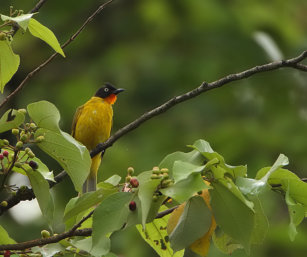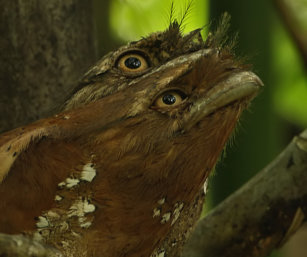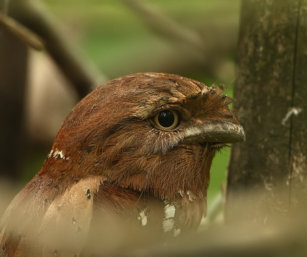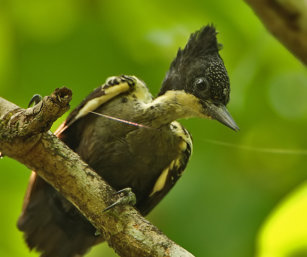Goa, June 2008
Backwoods blast!
For the first time visitor, Goa throws itself on you! The strong smell of the sea, the sand and the fish welcome you with opens arms. Our trip was just before the monsoon arrived (in early-June linked with an ‘applied behavior’ workshop Ramki had to attend in Goa!) to photograph the Blue-eared and the Collared Kingfisher. Unfortunately, as the sea was choppy the Collared was struck off our list even before we landed in Goa.
Ajit, friendly and highly Goan, was waiting for us at the airport with his car. He soon got us out of the crowded noisy area on to the highway, cruising at a steady pace. Sitting inside the car one cannot resist the green around to envelope you. Not many first-timers would be aware of the lushness that awaits at Goa. Be prepared to see green, green and more green and definitely not coconut trees!

After a couple of hours (65km), we drove into the quite trail leading to the delightful Backwoods birding camp. Tucked at the end of the trail with thick rain forest of the Bhagwan Mahavir Sanctuary on one side and a small village on the other, the camp’s location was a perfect setting for the birder. A quaint, charming and almost inconspicuous board welcomed us. The camp has a main building built on the lines of local architecture, with two rooms in the ground floor, two at the first, a large living area, a dining area, a lovely portico and small balconies overlooking lush greenery. We stayed in the main building, which normally is not given out to visitors during the season.
The path leading up to the building is nicely paved with a small pond in the middle that attracts Puff-throated Babblers, Orange-headed Ground Thrushes and Dark-fronted Babblers. During peak birding season (November to March) Backwoods’ six well-furnished cottages and six spacious tented cottages with attached baths are let out for birdwatchers and birding groups. The evening sun was to soon go into hiding and I was keen on some views of the frogmouth, which was last spotted fairly close to the camp. Two of the camp staff (all of them local young guys) set off to find the roosting site and were back in minutes with beaming smiles.
I followed them into the bamboo thicket and just a few feet off the trail was a pair of frogmouths perching on a wet branch, oblivious to our prying glances and binocular peeps. My day had signed off beautifully. Next morning Leio De Souza, one of the promoters of the camp, a fine birder himself, was there to meet us. He had finished a late night birthday party in Panjim (downtown Goa) and was back in the wee hours to guide us into the green paradise called Bhagwan Mahavir Sanctuary. We birded in and around the camp. The highlights for the morning were wonderful views of the Heart-spotted woodpecker pecking on a low branch and a Crested Goshawk sitting pretty atop a tall tree. After a hearty breakfast, it was birding time again.
We drove a few kilometers from the camp, parked the car off the road and entered the woods. There were a number of Crested treeswifts on the bare tree branches along the road. So were the Malabar parakeets. The Malabar trogon also gave us great views with many opportunities to capture it on camera. Later in the afternoon, we decided to chase the blue-eared kingfisher, our prime target. Our birding site was the dense evergreen forest around the Tambdi Surla Mahadev temple set on the banks of the river Surla.
This jain style temple of Lord Shiva, stands out in stark contrast to its green backdrop. Built in the 13th century, the black basalt structure is beautifully and intricately carved with perfect proportions. A flight of steps leads you to the river and a small climb takes you to the forest. This patch of forest is prime birding country and most of the specialities are fairly common here. After a brief search we spotted the tiny jewel – the Blue-eared Kingfisher flitting from the water to a low lying branch with regular shrill calls. He would go back and forth often and sit on his perch giving us great opportunities to get him on camera.
This patch also produced several Grey-headed bulbuls, Crimson-fronted Barbets, Malabar Pied Hornbills, Little Spiderhunters, Flame-throated Bulbuls, etc. The next day we decided to explore the open grassland behind the camp. A defunct agricultural land, lined with tall trees along its borders was our site for the morning. The evening before we had heard hornbills roosting in these trees and we thought of trying our luck in the morning. More Orange-headed thrushes, parakeets and tree swifts. We were just in time to see the hornbills fly away for the day. Later in the day we explored another part of the forest nearby.
We got lucky with the highly vocal White-bellied woodpecker, the Lesser Yellownape, Fairy Bluebird, Grey-headed and Flame-throated bulbuls. Backwoods, as Leio puts it, is a camp “run by birders for birders” and is definitely worth a visit for any birder / bird photographer especially to cover most of the coveted Western Ghats endemics. With two more birders (Pramod and Loven) as the promoters of Backwoods, the choice of location of the camp is unbeatable.
In the camp itself and its surroundings, it is possible to see 13 endemics: Nilgiri Woodpigeon, Malabar Grey Hornbill, Malabar (Crimson-fronted) Barbet, Malabar Lark, Malabar Parakeet, Malabar (Large) Woodshrike, Flame-throated (Black-crested) Bulbul, Grey-headed Bulbul, White-bellied Blue Flycatcher, Nilgiri (Plain) Flowerpecker, Small (Crimson-backed) Sunbird, Vigors’s (Crimson) Sunbird, and Malabar White-headed (Chestnut-tailed) Starling. Other specialities of the area include Forest (Spot-bellied) Eagle-owl, Sri Lanka Frogmouth, Malabar Trogon, Malabar Pied and Great Pied Hornbills, Collared Blue-eared and Black-backed (Oriental) Dwarf Kingfishers, and Malabar Whistling Thrush.
For detailed information about Backwoods please visit their informative website. Leio also regularly helps rehab wounded birds brought in from the neighboring villagers. During our stay, Leio was nursing a wounded juvenile Spot-bellied Eagle Owl which seemed to react positively to all the attention. He became more confident, less shy with the camp inmates and was starting to eat well. Overall, inspite of the short trip and the onset of the monsoon, birding in and around Backwoods was nothing short of spectacular. We will definitely return for a longer trip in better weather though monsoon in the jungle has its own charm.
Cheers, –swarna | Aug 2008











































